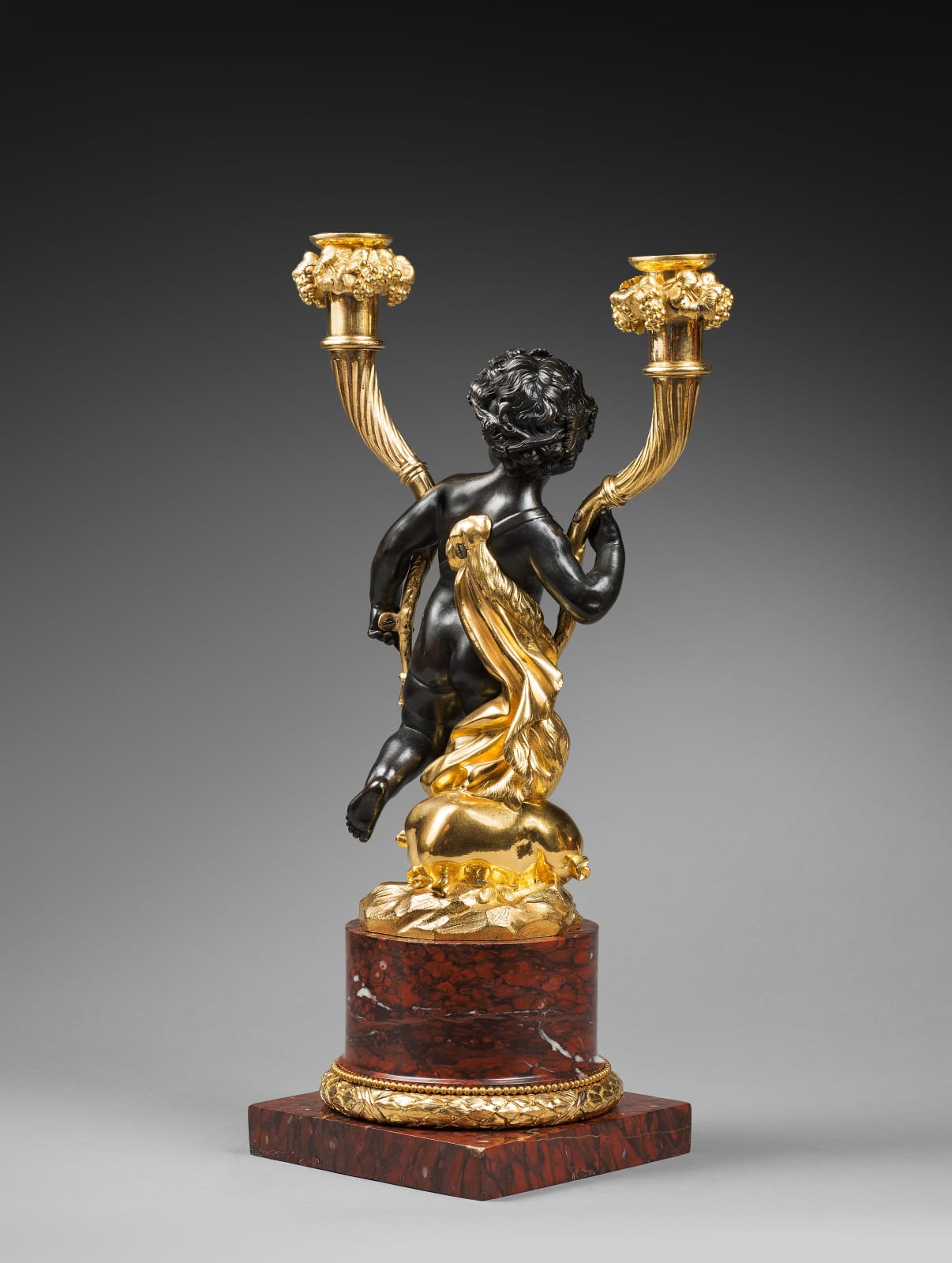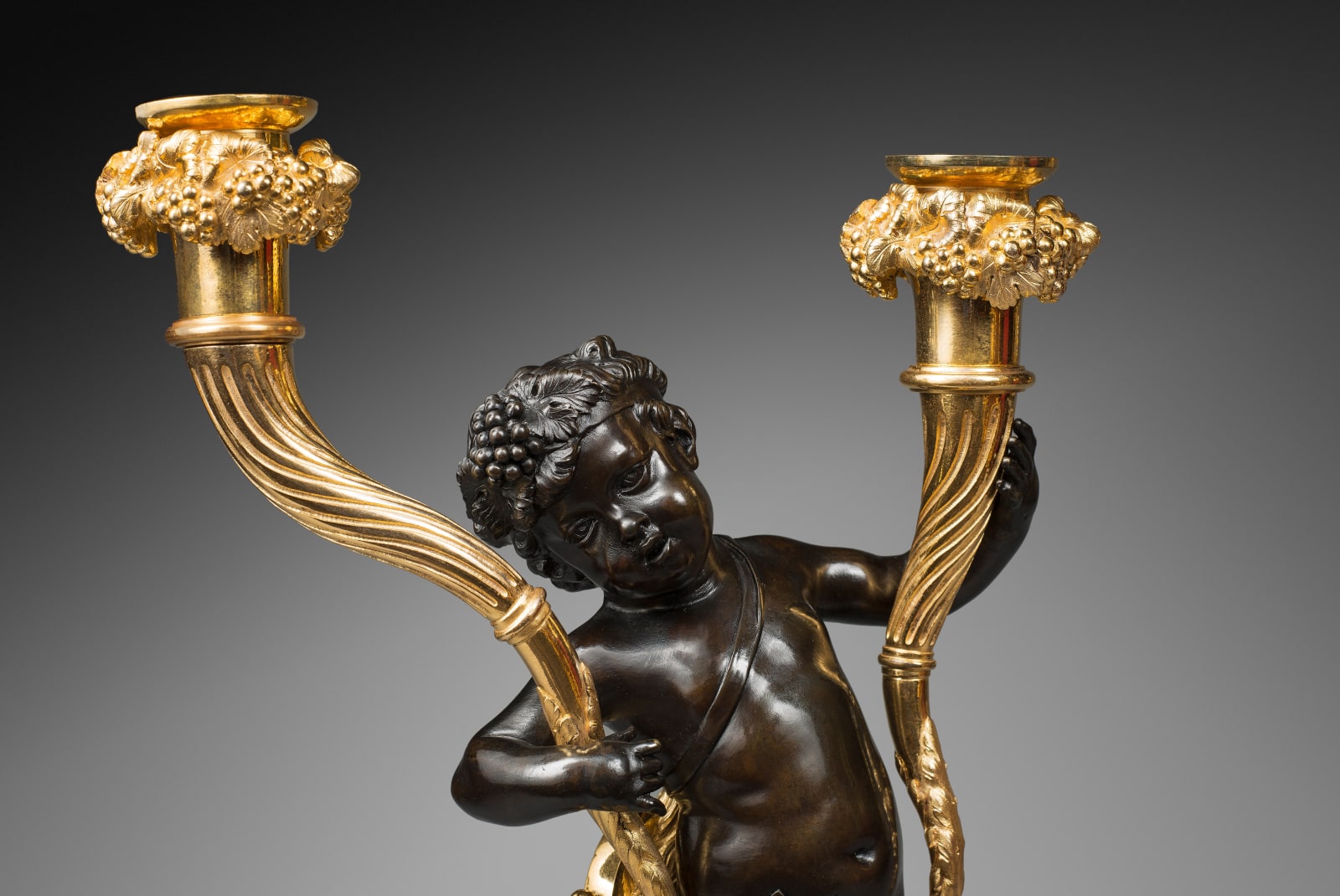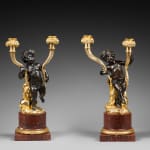Clodion (attributed to)
Further images
Literature
Hans Ottomeyer and Peter Pröschel, “Vergoldete Bronzen”, 1986, p. 210, colour pl. XXVIII, illustrating a candelabrum by Louis Félix de La Rue that is very similar to the present left hand model and p. 422, pl. 6.3.1, illustrating a sheet from a Eugène Bagues of Paris catalogue of 1880 in the Musée des Art Décoratifs, Paris, which shows almost identical candelabra.
A fine pair of Louis XVI gilt and patinated bronze and red marble figural candelabra attributed to Clodion, each formed as a dancing infant Bacchus with fruiting vine headdress and nude except for a vine-leaf loincloth, holding in each hand a spirally fluted cornucopiae branches spilling over with grapes and terminated by beaded nozzles, both standing on a rocky base spread with a lion pelt, one infant with a tambourine and upturned vase, the other with a sack, on a stop fluted circular red marble pedestal with beaded and ribbon-tied laurel plinth, on a beaded square stepped base with burnished panels
Paris, date circa 1780
Height 43 cm. each.
These finely modelled bronzes relate closely with the work of the sculptors, Claude Michel, known as Claude Michel, known as Clodion (1738–1814) as well as Louis Félix de La Rue (b. 1720 or 31 d. 1765 or 77). However as the Parisian nineteenth century bronzier Eugène Bagues advertised identical models, albeit with differing bronze bases, in their illustrated catalogue, which were described as ‘Bouts de table Clodion’ it is fair to assume an attribution to Clodion as correct. Considered the finest modeller of small-scale lyric statuettes of the late eighteenth century, Clodion often created works of a Bacchanalian nature similar to the present infants as well as Satyrs and Maenads. Born in Nancy, he belonged to a family of well-known sculptors; during his youth he went to Paris where he worked with his uncle, Lambert-Sigisbert Adam, and subsequently with Jean-Baptiste Pigalle (1714 d. circa 1785). After winning the Prix de Rome in 1759, Clodion spent about ten years in Italy studying Roman antiquities, Roman Baroque sculpture, and the art of his contemporaries, from Giovanni Battista Piranesi (1720-78) to Johan Tobias Sergel (1740-1814). As a student at the FrenchAcademy in Rome, his prodigious talents, especially his special aptitude for small terracottas, attracted an illustrious clientele, including Catherine the Great. On his return to Paris in 1771, Clodion’s successes multiplied. He received major commissions for public and church monuments and produced countless models for vases, bas-reliefs, clocks, and other decorative projects. As a supporter of the crown, he fled Paris during the Revolution, returning in about 1797. Clodion sought new patrons among Napoleon’s court and admirers but his style was considered outmoded and demand for his work diminished but today his work is considered the finest expression of late eighteenth century elegance and taste. Examples of his oeuvre can be found among many important collections in the world including the museums of Berlin, Cherbourg, Dieppe, Montpellier, Gallery Roumianzeff Moscow, Nantes, Orléans and the gardens of Château Versailles.
The present candelabra are identical to a pair acquired by Djahanguir Riahi, which were included in the sale of his celebrated collection held at Christie’s New York, 2nd November 2000. Such models enjoyed enormous success during the eighteenth and nineteenth centuries and were particularly admired by English collectors during the 1800’s. For instance a pair of the same design but with bronze bases, was purchased by a Mr. Fortnum in London 1852 from the collection of Léopold I, King of the Belgians and is now housed at the Ashmolean Museum, Oxford. Further distinguished collectors to own such pairs include the comtesse de Flahaut at Coventry House, London in 1863, whose candelabra were subsequently sold by the Trustees of the Meiklour Settlement in London. Another pair formerly owned by the 6th Lord Ashburton K.C.V.O. was sold at auction in London, 1964.





